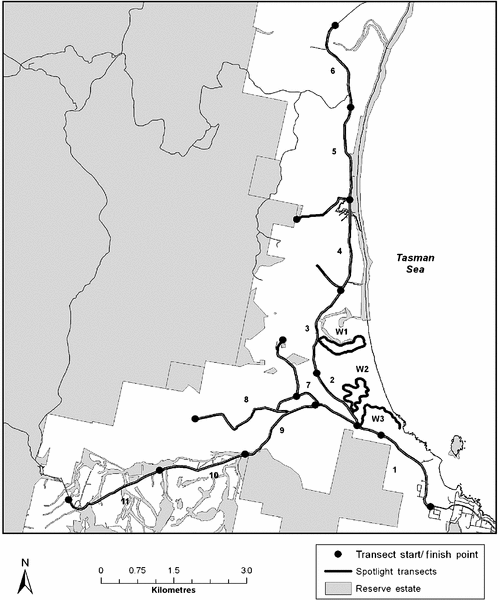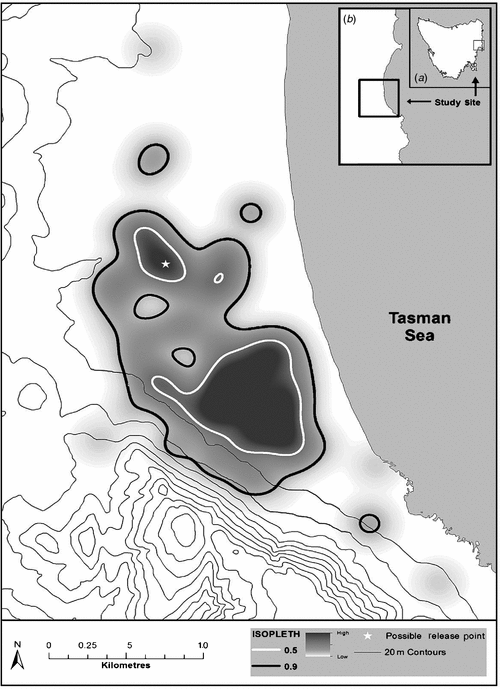Surviving in the south: a recent incursion of the agile wallaby (Macropus agilis) in Tasmania
Matthew Pauza A B , Jim Richley A , Sue Robinson A and Simon Fearn AA Invasive Species Branch, Tasmanian Department of Primary Industries, Parks, Water and Environment, GPO Box 44, Hobart, Tas. 7001, Australia.
B Corresponding author. Email: matthew.pauza@dpipwe.tas.gov.au
Australian Mammalogy 36(1) 95-98 https://doi.org/10.1071/AM13029
Submitted: 21 May 2013 Accepted: 30 October 2013 Published: 19 December 2013
Abstract
The agile wallaby (Macropus agilis) has established in a small area of coastal plain on the central east coast of Tasmania. The Tasmanian occurrence is the only known population of this species outside its natural geographical range. The current wild population is likely to have originated from a small number of individuals that escaped or were released from a nearby wildlife park in the late 1990s. The population is successfully reproducing although it appears to be relatively small and restricted. A precautionary approach is needed and the eradication of the population is recommended.
Additional keywords: eradication, invasive species, Macropus agilis, zoo escape.
Introduction
In total, 44 non-indigenous vertebrates have been recorded in Tasmania, including 21 birds, 13 mammals, nine freshwater fish and a single reptile species (Mallick and Driessen 2009). The presence of some these species is considered a threat to the biodiversity of Tasmania, although their distribution and impacts on the island’s environment remains, in most cases, poorly understood and undermanaged. The intentional and accidental release of non-indigenous species from captivity has been identified as one of the primary avenues for contemporary vertebrate incursion (Fàbregas et al. 2010); however, the extent to which this has occurred in Tasmania remains unclear.
Here we examine the recent incursion from captivity and subsequent establishment and spread of Macropus agilis in the central east coast of Tasmania. The aim of this study is to delimit the distribution of the species in the region, outline the basis for management and provide a recommendation for future control.
Methods
Estimates of the distribution of M. agilis were carried out every 1–2 weeks between September 2012 and February 2013, with a total of 14 replicate surveys completed in the study area. The extent of the survey period was largely governed by access to private lands and favourable weather and fire conditions during the study period. Eleven vehicle-based spotlight transects, each 2000 m in length, were established to cover all formed roads in the study area. Three foot-based spotlight transects, ranging in length from 200 m to 1200 m, were established adjacent to the likely point of release from the wildlife park (Fig. 1). Surveys were conducted using a 500-lumen hand-held spotlight (Led Lenser X7R 027897, Zweibrueder Optoelectronics GmbH & Co.KG, Solingen, Germany) between the hours of 21 : 30 and 02 : 30 when most macropods appeared to be active. All vehicle-based transects were surveyed in a single night, with foot-based transects surveyed on the following night. The location of sighted M. agilis was determined by observing adjacent landmarks and features and an approximate location was recorded with a GPS (Garmin 60xt, Garmin, Olathe, Kansas, USA.).

|
Density distribution of M. agilis sightings was determined using fixed-kernel density estimates in geospatial modelling environment software (ver. 0.7.2.0) in ARC GIS 10.1. The kernel bandwidth was set at 10 000 and the output cell size to 1 m2. These parameters were based on thorough visual assessment of kernel density contours during tests of various bandwidths (Beyer 2004). The 50% and 90% density distribution isopleths were added to define the core density distribution areas for future management (Fig. 2).

|
Results and discussion
A total of 168 sightings of M. agilis were recorded during the 14 surveys with an average of 12 wallabies detected during each survey period. The kernel density estimate of sighting locations (Fig. 2) demonstrates that the landscape adjacent to the possible release site is not used evenly. The high-density-sighting areas (50% isopleth) are disjunct, with two distinct regions: (1) directly adjacent to the possible release site, and (2) ~1000 m south-east of the possible release site. Most sightings (90% isopleth) are within an area of 184 ha surrounding the possible release site. This area forms the core sighting distribution area and defines a focus for future management.
The impacts of M. agilis in a novel environment are unknown and may not yet be fully realised. The potential threats posed by the species have been identified and include: their spread to nearby National Parks and Conservation Areas, hybridisation with the native sympatric Bennett’s wallaby (Macropus rufogriseus), competition for food resources, territory and shelter with indigenous marsupials, and increased grazing and browsing pressure on agricultural lands and periurban gardens (Ramsey and Wilson 1997; Lowry et al. 1995).
The wild population of M. agilis is interacting directly with Bennett’s wallaby through the use of similar habitats and formation of mixed species mobs in the area. This is likely to increase the encounter rate between the two species and therefore the potential for interspecific hybridisation. The outcome of such hybridisation raises a range of complex species conservation and management issues. A pre-emptive approach to eradicate M. agilis and eliminate the possibility of hybridisation and further expansion is therefore recommended. The opportunity to eradicate M. agilis from Tasmania has been assessed through a feasibility process (Invasive Species Branch 2012). The primary factors that define the feasibility of eradication are the relatively small population size and confined distribution of M. agilis, as documented in this study. Eradication is likely to be the most economically and ecologically sensible solution in the long term (Simberloff 2011).
We recommend that the existing population be eradicated before environmental conditions and population status change to favour a further expansion that would ultimately make the future task of control or eradication difficult. The opportunity to collect as much biological information from the carcasses will be useful to inform future management or incursion response strategies to the risk of establishment of non-indigenous macropods in Tasmania.
Acknowledgements
We thank S. Locke for his invaluable help and knowledge during long nights in the field. Thank you to our partners and friends that tolerated our late nights in the field and time away from home. This study was made possible through the resources of the Invasive Species Branch, Tasmanian Department of Primary Industries, Parks, Water and Environment
References
Beyer, H. L. (2004). Hawth’s analysis tools for ArcGIS. Available at http://www.spatialecology.com/htools/.Fàbregas, M. C., Guillén-Salazar, F., and Garcés-Narro, C. (2010). The risk of zoological parks as potential pathways for the introduction of non-indigenous species. Biological Invasions 12, 3627–3636.
| The risk of zoological parks as potential pathways for the introduction of non-indigenous species.Crossref | GoogleScholarGoogle Scholar |
Invasive Species Branch (2012). Feasibility report: eradication of agile wallabies Macropus agilis. Department of Primary Industries, Parks, Water and Environment, Tasmania.
Lowry, P. S., Eldridge, M. D. B., and Johnston, P. G. (1995). Genetic analysis of a female macropod hybrid (Macropus agilis × M. rufogriseus) and her backcross offspring. Australian Mammalogy 18, 79–82.
Mallick, S. A., and Driessen, M. M. (2009). Review, risk assessment and management of introduced animals in the Tasmanian Wilderness World Heritage Area. Nature Conservation Report 10/01. Department of Primary Industries, Parks, Water and Environment, Tasmania.
Ramsey, D. S. L., and Wilson, J. C. (1997). The impact of grazing by macropods on coastal foredune vegetation in southeast Queensland. Australian Journal of Ecology 22, 288–297.
| The impact of grazing by macropods on coastal foredune vegetation in southeast Queensland.Crossref | GoogleScholarGoogle Scholar |
Simberloff, D. (2011). How common are invasion-induced ecosystem impacts? Biological Invasions 13, 1255–1268.
| How common are invasion-induced ecosystem impacts?Crossref | GoogleScholarGoogle Scholar |


